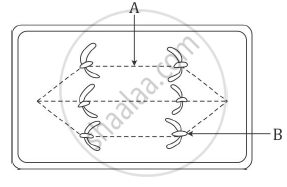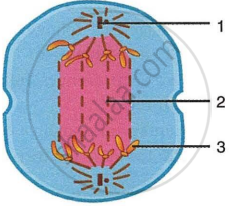Advertisements
Advertisements
Question
With the help of suitable diagrams, explain the five stages of prophase-I of meiosis.
Solution
Prophase I is the longest phase of meiosis and is further sub divided into 5 phases:
- Leptotene

Condensation makes chromosomes become distinct and compact. - Zygotene

Homologous chromosomes start pairing together by a process called synapsis to form a complex structure called synaptonemal complex. Two synapsed homologous chromosomes form a complex called bivalent or tetrad. - Pachytene

Longest phase of prophase I
Recombination nodules appear in this stage at the sites where crossing over has to take place between non-sister chromatids of homologous chromosomes. - Diplotene

Synaptonemal complex dissolves and recombinants separate from each other except at crossover sites to form X-shaped structure called chiasmata. - Diakinesis

Chiasmata terminalises and chromosomes condense. Meiotic spindle assembles and nucleolus and nuclear envelope disappear.
APPEARS IN
RELATED QUESTIONS
The diagram given below represents a certain stage of mitosis:

- Identify the stage of cell division.
- Name the parts labelled A and B.
- What is the unique feature observed in this stage?
- How many daughter cells are formed from this type of cell division?
The diagram given below represents a stage during cell division.
Study the same and answer the questions that follow:

- Identify whether it is a plant cell or an animal cell. Give a reason in support of your answer.
- Name the stage depicted in the diagram. What is the unique feature observed in this stage?
- Name the type of cell division that occurs during:
- Replacement of old leaves by new ones
- Formation of gametes
- What is the stage that comes before the stage shown in the diagram?
- Draw a neat, labelled diagram of the stage mentioned in (iv) above keeping the chromosome number constant.
The diagram below represents a stage during cell division. Study the same and then answer the questions that follow:

- Name the parts labelled 1, 2, and 3.
- Identify the above stage and give a reason to support your answer.
- Mention where in the body this type of cell division occurs.
- Name the stage prior to this stage and draw a diagram to represent the same.
Genetic recombination occurs in ______ phase of prophase of meiosis-I.
Fill in the blank and explain the statement.
All chromosomes are arranged parallel to equatorial plane of cell in ______ phase of mitosis.
Fill in the blank and explain the statement.
For formation of plasma membrane, ____________ molecules are necessary.
Define the following:
Karyokinesis
Fill in the blank:
______ is the indirect cell division.
In which one of the following options the two stages of mitosis have been given in correct sequence?
Explain the Term Cell Diakinesis
Name the following:
Mitosis takes place in which cells.
Complete the following sentence with appropriate word :
______means the splitting of the nucleus.
Write the functional activity of the following structure:
Colchicine
Give the sequence of the events occurring during the prophase of mitosis.
During Mitosis what is the position of chromatids in metaphase?
The phase of karyokinesis which is almost the reverse of prophase is ______.
Name these:
Two steps of the process Mitosis
